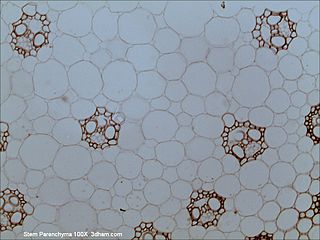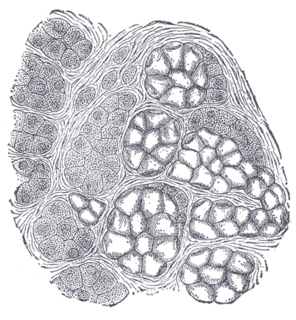
Parenchyma is the bulk of a substance. In animals, a parenchyma comprises the functional parts of an organ and in plants parenchyma is the ground tissue of nonwoody structures.
Terminologia Anatomica (TA) is the international standard on human anatomic terminology. It was developed by the Federative Committee on Anatomical Terminology (FCAT) and the International Federation of Associations of Anatomists (IFAA) and was released in 1998. It supersedes the previous standard, Nomina Anatomica. Terminologia Anatomica contains terminology for about 7500 human gross (macroscopic) anatomical structures. In April 2011, Terminologia Anatomica was published online by the Federative International Programme on Anatomical Terminologies (FIPAT), the successor of FCAT.

The renal fascia or Gerota's fascia is a layer of connective tissue encapsulating the kidneys and the adrenal glands. The renal fascia separates the adipose capsule of kidney from the overlying pararenal fat. The deeper layers below the renal fascia are, in order, the adipose capsule, the renal capsule and finally the parenchyma of the renal cortex. The spaces about the kidney are typically divided into three compartments: the perinephric space and the anterior and posterior pararenal spaces.

Adenosquamous carcinoma is a type of cancer that contains two types of cells: squamous cells and gland-like cells. It has been associated with more aggressive characteristics when compared to adenocarcinoma in certain cancers.
ALVAC-CEA vaccine is a cancer vaccine containing a canary pox virus (ALVAC) combined with the carcinoembryonic antigen (CEA) human gene.

Carcinosarcomas are malignant tumors that consist of a mixture of carcinoma and sarcoma. Carcinosarcomas are rare tumors, and can arise in diverse organs, such as the skin, salivary glands, lungs, the esophagus, pancreas, colon, uterus and ovaries.
A stromal tumor is a tumor that arises in the supporting connective tissue of an organ.

Thymic carcinoma is a rare type of thymus gland cancer. It usually spreads, has a high risk of recurrence, and has a poor survival rate. Thymic carcinoma is divided into subtypes, depending on the types of cells in which the cancer began. Also called type C thymoma.
Transsphenoidal surgery is a type of surgery in which an endoscope and/or surgical instruments are inserted into part of the brain by going through the nose and the sphenoid bone into the sphenoidal sinus cavity. Transsphenoidal surgery is used to remove tumors of the pituitary gland..
Wedge resection is a surgical procedure to remove a triangle-shaped slice of tissue. It may be used to remove a tumor or some other type of tissue that requires removal and typically includes a small amount of normal tissue around it.
It is easy to repair, does not greatly distort the shape of the underlying organ and leaves just a single stitch line as a residual.

Salivary gland tumours or neoplasms are tumours that form in the tissues of salivary glands. The salivary glands are classified as major or minor. The major salivary glands consist of the parotid, submandibular, and sublingual glands. The minor salivary glands consist of 800-1000 small mucus-secreting glands located throughout the lining of the oral cavity.
Idiopathic pneumonia syndrome is a set of pneumonia-like symptoms that occur with no sign of infection in the lung. Idiopathic pneumonia syndrome is a serious condition that can occur after a stem cell transplant. It occurs between 2.2 and 15 percent of hematopoietic stem cell transplants. The incubation period ranges between 4 to 106 days, but mostly is about 22 days from transplant.
Spindle cell carcinoma is a type of cancer that begins in the skin or in tissues that line or cover internal organs and that contains long spindle-shaped cells. It is also called sarcomatoid carcinoma.
Peritoneal fluid is a liquid made in the abdominal cavity which lubricates the surface of tissue that lines the abdominal wall and pelvic cavity. It covers most of the organs in the abdomen. An increased volume of peritoneal fluid is called ascites.
A papillary tumor is a tumor shaped like a small mushroom, with its stem attached to the epithelial layer of an organ.

Mucinous carcinoma is a type of cancer that arises from epithelial cells; these line certain internal organs and skin, and produce mucin.

Parathyroid carcinoma is a rare cancer resulting in parathyroid adenoma to carcinoma progression. It forms in tissues of one or more of the parathyroid glands.
Segmental resection is a surgical procedure to remove part of an organ or gland, as a sub-type of a resection, which might involve removing the whole body part. It may also be used to remove a tumor and normal tissue around it. In lung cancer surgery, segmental resection refers to removing a section of a lobe of the lung. The resection margin is the edge of the removed tissue; it is important that this shows free of cancerous cells on examination by a pathologist.
A fungating lesion is a skin lesion that fungates, that is, becomes like a fungus in its appearance or growth rate. It is marked by ulcerations and necrosis and usually presents a foul odor. This kind of lesion may occur in many types of cancer, including breast cancer, melanoma, and squamous cell carcinoma, and especially in advanced disease. The characteristic malodorous smell is caused by dimethyl trisulfide. It is usually not literally a fungal infection but rather a neoplastic growth with necrosing portions.
Vulvar tumors are those neoplasms of the vulva. Vulvar and vaginal neoplasms make up a small percentage (3%) of female genital cancers. They can be benign or malignant. Vulvar neoplasms are divided into cystic or solid lesions and other mixed types. Vulvar cancers are those malignant neoplasms that originate from vulvar epithelium, while vulvar sarcomas develop from non-epithelial cells such as bone, cartilage, fat, muscle, blood vessels, or other connective or supportive tissue. Epithelial and mesenchymal tissue are the origin of vulvar tumors.









